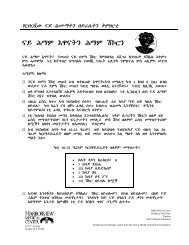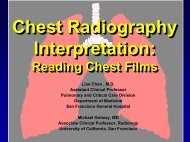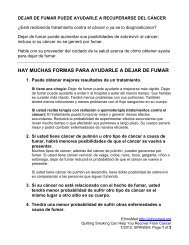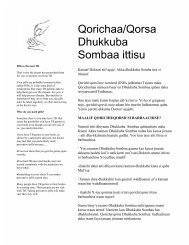Somali Knowledge Attitude Practices Study (KAPS) - EthnoMed
Somali Knowledge Attitude Practices Study (KAPS) - EthnoMed
Somali Knowledge Attitude Practices Study (KAPS) - EthnoMed
You also want an ePaper? Increase the reach of your titles
YUMPU automatically turns print PDFs into web optimized ePapers that Google loves.
3.2.2. Health Seeking in NEZ<br />
Health seeking among Pastoral-cum- Agropastoral in Puntland<br />
The most commonly reported illnesses among pastoral communities are diarrhoea, malaria,<br />
respiratory tract infections, such as colds and cough, intestinal worms, malnutrition, skin<br />
infections and convulsions. It should be noted that convulsions normally manifest in conditions in<br />
which fever is symptomatic.<br />
Diarrhoea is basically managed through administration of ORS and if the child does not recover it<br />
is taken to a health facility for better management. Some of the cases are treated using rice water<br />
or herbal cures.<br />
The parents of the child make the decision on where a sick child is to be managed or treated while<br />
the condition (state of illness) is applied in deciding when to seek help. Nonetheless there are<br />
some cases where it is only the father who can make such decisions.<br />
Social networks: If a mother has to be away with a sick child, she may take all the young children<br />
with her or leave them with a neighbour.<br />
<strong>Knowledge</strong>, <strong>Attitude</strong> and <strong>Practices</strong><br />
The childhood illnesses among the agro-pastoral population are malaria, diarrhoea, respiratory<br />
tract infections (coughs and bronchitis), eye infections, intestinal parasites and measles. However<br />
diarrhoea and malaria are the most common illnesses among young children. The types of<br />
common intestinal parasites among children are giardia, amoeba, ascaris and thread worms.<br />
Giardia and amoeba are the most common; affecting 56% and 48% respectively of children under<br />
the age of five years. Overall prevalence of infestation with intestinal worms among children was<br />
estimated to be 80%.<br />
Diarrhoea: Poor sanitation, in which lack of use of latrines was mentioned as an indicator is<br />
considered to be the main cause of diarrhoea. It was reported that many households do not have<br />
and therefore do not use latrines. Instead they use bushes. It was explained that when it rains, the<br />
water carries the faecal matter with it and contaminates the water sources for domestic water.<br />
Malaria: It was reported that rain water forms pools that then become breeding sites for<br />
mosquitoes.<br />
People have the alternative of seeking treatment from traditional healers or modern health<br />
facilities or buying medicines. Diseases that are commonly treated by traditional healers include<br />
diarrhoea, measles, stomach ulcers (gastritis) and teeth problems. Gonorrhoeal was also<br />
mentioned but clarified that this is common among adults.<br />
The current view is that the number of patients seeking the services of traditional healers is<br />
decreasing, indeed it was estimated that while 89% of the cases will be managed at a health<br />
facility or have drugs bought only 11% will be managed under traditional healers. This is the<br />
estimated proportion of people who belief that traditional cures are more effective than modern<br />
treatment. It was further explained that, having grown-up at a time when traditional healers were<br />
solely responsible for treating and managing people’s health, about 67% of the aged people do<br />
not believe in modern health services and hence are still dependent on traditional cures.<br />
43






